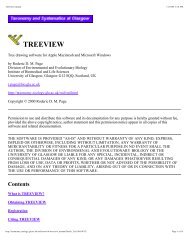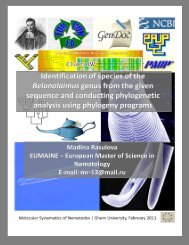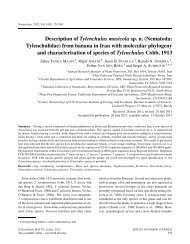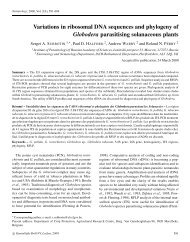Identification of cyst forming nematodes of the genus Heterodera ...
Identification of cyst forming nematodes of the genus Heterodera ...
Identification of cyst forming nematodes of the genus Heterodera ...
You also want an ePaper? Increase the reach of your titles
YUMPU automatically turns print PDFs into web optimized ePapers that Google loves.
S.A. Subbotin et al.<br />
Digestion with 23 out <strong>of</strong> <strong>the</strong> 26 enzymes gave RFLPs<br />
for all species studied; BamHI, HindIII, and KpnI did<br />
not restrict any <strong>of</strong> <strong>the</strong> ampli ed products. No single<br />
enzyme could distinguish all <strong>cyst</strong> <strong>forming</strong> species in<br />
this study, although some yielded much more taxonomic<br />
information than o<strong>the</strong>rs (Table 2). For example, CfoI<br />
(Fig. 1G) yielded 16 polymorphic patterns distinguishing<br />
12 out <strong>of</strong> <strong>the</strong> 26 species. AluI (Fig. 1A), BsuRI (Fig. 1F),<br />
Bsh1236I (Fig. 1C), and ScrFI (Fig. 2F) each produced<br />
15 polymorphic patterns and distinguished nine, ten, 11,<br />
and nine species, respectively. The combination <strong>of</strong> <strong>the</strong><br />
patterns obtained by seven individual enzymes allowed<br />
differentiation <strong>of</strong> most species under study (Table 3). In<br />
some cases <strong>the</strong> sum <strong>of</strong> restricted fragments length was less<br />
than 1060 bp. This could be due to production <strong>of</strong> several<br />
fragments with similar sizes or/and <strong>of</strong> fragments smaller<br />
that 100 bp which were poorly visible on <strong>the</strong> agarose<br />
gels. Sometimes <strong>the</strong> sum <strong>of</strong> restricted fragment lengths<br />
was more than <strong>the</strong> length <strong>of</strong> <strong>the</strong> unrestricted ampli ed<br />
product. Repeated digestion with an extended digestion<br />
period suggested heterogeneity<strong>of</strong> ITS regions was present<br />
in <strong>the</strong> genome <strong>of</strong> <strong>the</strong>se species.<br />
RFLP <strong>of</strong> ITS regions allowed clear differentiation <strong>of</strong><br />
most agriculturally important <strong>cyst</strong> <strong>forming</strong> nematode species<br />
from each o<strong>the</strong>r and from <strong>the</strong>ir sibling species. Some<br />
restriction enzymes produced a RFLP pattern speci c for<br />
a species group. For example <strong>the</strong> patterns obtained after<br />
restriction with AluI (Fig. 1A), Bsh1236I (Fig. 1C),<br />
BsuRI (Fig. 1F), DdeI (Fig. 1H), HinfI (data not shown)<br />
and EcoRI (Fig. 2A) distinguished <strong>the</strong> H. schachtii s. str.<br />
group from <strong>the</strong> o<strong>the</strong>r groups, whereas EcoRI restricted<br />
only ITS regions <strong>of</strong> species from this group. BglI (data<br />
not shown), BsiZI (Fig. 1D), Bsp143I (Fig. 1E), BsuRI<br />
(Fig. 1F), and PstI (Fig. 2D) separated <strong>the</strong> H. goettingiana<br />
group species having juveniles with four incisures<br />
(H. carotae, H. cruciferae, H. goettingiana and H. urticae)<br />
from o<strong>the</strong>r species. Some enzymes proved to be <strong>of</strong><br />
little use for identi cation <strong>of</strong> larger numbers <strong>of</strong> <strong>the</strong> species<br />
but were extremely adequate for individual species. SspI<br />
(data not shown), for example, only restricted PCR products<br />
from H. latipons and M. alni, whereas <strong>the</strong> ITS from<br />
<strong>Heterodera</strong> sp. was only cut by XbaI (data not shown).<br />
BsiZI (Fig. 1D) and DdeI (Fig. 1H) restricted <strong>the</strong> ITS region<br />
<strong>of</strong> all species, except H. litoralis.<br />
As we observed earlier (Subbotin et al., 1997), European<br />
populations <strong>of</strong> H. avenae (type A) were easily<br />
separated from o<strong>the</strong>r species with AluI (Fig. 1A) which<br />
digested <strong>the</strong> ITS regions <strong>of</strong> all studied <strong>nematodes</strong>, except<br />
those <strong>of</strong> H. arenaria. No enzymes distinguished<br />
European populations <strong>of</strong> H. avenae from H. arenaria.<br />
H. lipjevi was easily distinguished from all species by<br />
PstI (Fig. 2D), BsuRI (Fig. 1F) and TaqI (Fig. 2H),<br />
which produced unique RFLP patterns for this species.<br />
H. aucklandica was separated by CfoI (Fig. 1G) from<br />
o<strong>the</strong>r species. Bsh1236I (Fig. 1C), CfoI (Fig. 1G) and<br />
ScrFI (Fig. 2F) produceduniquepatterns for H. iri. H. latipons<br />
was separated from <strong>the</strong> o<strong>the</strong>rs by AluI (Fig. 1A),<br />
Bsh1236I(Fig. 1C), BsuRI (Fig. 1F), CfoI (Fig. 1G), DdeI<br />
(Fig. 1H), PvuII, RsaI (Fig. 2E), and SspI. H. hordecalis<br />
was distinguishedby Bsh1236I(Fig. 1C), BsuRI (Fig. 1F),<br />
MvaI (Fig. 2C), and ScrFI (Fig. 2F).<br />
AluI, AvaI, CfoI, HpaII, MvaI, RsaI and ScrFI separated<br />
<strong>the</strong> closely related and morphologically poorly distinguished<br />
species from <strong>the</strong> H. schachtii s. str. group<br />
(H. schachtii, H. glycines, H. trifolii, H. medicaginis and<br />
H. ciceri) from each o<strong>the</strong>r and all o<strong>the</strong>r species. MvaI<br />
(Fig. 2C), PvuII, RsaI (Figs 2E, 3) and ScrFI (Fig. 2F)<br />
produced a speci c pattern for H. schachtii, which separated<br />
this species from o<strong>the</strong>rs. Restrictions with MvaI,<br />
RsaI, HpaII, or PvuII did not show intraspeci c variation<br />
in restriction patterns between <strong>the</strong> three H. schachtii populations<br />
under study (Fig. 3). Totalling <strong>the</strong> fragment sizes<br />
produced by MvaI (Figs 2C, 3), RsaI (Figs 2E, 3), PvuII<br />
(Fig. 3), or ScrFI (Fig. 2F) yielded a sum <strong>of</strong> more than<br />
1060 bp, indicatinga heterogeneity<strong>of</strong> ITS regions present<br />
in <strong>the</strong> genome <strong>of</strong> H. schachtii populations. H. glycines,<br />
ano<strong>the</strong>r member <strong>of</strong> <strong>the</strong> H. schachtii s. str. group, was distinguished<br />
within this group by AvaI, which produced a<br />
pattern identical to that for H. cajani (Fig. 1B). H. cajani<br />
was easily separated from o<strong>the</strong>rs by many enzymes:<br />
AluI (Fig. 1A), Bsh1236I (Fig. 1C), BsiZI (Fig. 1D),<br />
BsuRI (Fig. 1F), CfoI (Fig. 1G), DdeI (Fig. 1H), HinfI,<br />
HpaII (Fig. 2B), ScrFI (Fig. 2F), TaqI (Fig. 2H) and<br />
Tru9I. RFLP patterns produced by CfoI (Fig. 1G) separated<br />
H. ciceri from o<strong>the</strong>rs. Heterogeneity <strong>of</strong> <strong>the</strong> ITS<br />
region was observed for H. ciceri with AluI (Fig. 1A),<br />
CfoI (Fig. 1G), RsaI (Fig. 2E). Combinations <strong>of</strong> at least<br />
two restriction enzymes separated o<strong>the</strong>r species from this<br />
H. schachtii s. str. group. For example RsaI (Fig. 2E) distinguished<br />
H. trifolii and H. ciceri from o<strong>the</strong>r species,<br />
whilst CfoI (Fig. 1G) separated <strong>the</strong>se two species. RsaI<br />
(Fig. 2E) demonstrated heterogeneity <strong>of</strong> ITS regions in<br />
two populations <strong>of</strong> H. trifolii, and AluI in one population<br />
<strong>of</strong> this species. H. medicaginis was distinguished from<br />
o<strong>the</strong>r species by a combination <strong>of</strong> three enzymes: HpaII<br />
(Fig. 2B), MvaI (Fig. 2C), and AvaI (Fig. 1B; Table 3).<br />
H. salixophila belonging to <strong>the</strong> H. schachtii group, was<br />
separated from all species studied by Bsh1236I (Fig. 1C),<br />
156 Nematology
















